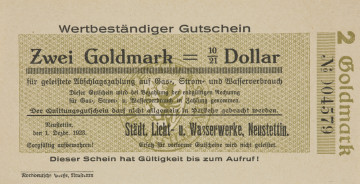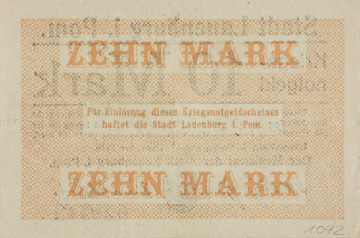
2 gold marks=10/21 dollars
1923
National Museum in Szczecin
Part of the collection: Paper money
In the late autumn of 1924, the idea of allowing so-called stable substitute money in circulation emerged in Germany. As a result, dollar-denominated gold marks appeared on the market with an official exchange rate pegged to the dollar at 4.20 gold marks = 1 dollar. Notes with a value of 4.20, 2.10, and 1.05 gold marks, as well as 20, 10, and 5 gold pfennig were put into the economy. The issue of gold marks pegged to dollars was made possible by an amendment to the “Act on Issuing and Redeeming Substitute Money” of 26 October 1923. This amendment all but legitimised the long-running process of settling trade relations in gold and foreign currencies. The substitute money was merely supposed to provide a systemic framework for the process by ensuring stable value. Every issue had to have a collateral. The issuer had to deposit treasury bills of the German Reich's gold loan in the Reich Bank on blocked deposit in the amount equal to the value of the substitute money issued. The collaterals in the form of valuable foreign currencies or dollar-denominated treasury bills was also permitted. What is more, the text on the note had to indicate that the holders can demand these notes to be exchanged for treasury bills for a stable loan of the German Reich, or the payment of the same amount in cash, and that the note was issued with the permission of the Reich Minister of Finance. All this information can also be found on the note issued by the city of Stralsund. The note – just like other substitute cash printed during the inflation period – is characterised by sparing graphic design and poor colours. The issue of stable-value replacement money to the market did not solve the problems pertinent on the German money market. In spite of official orders, the people treated this money with the same distrust as they had treated paper marks before.
Mieszko Pawłowski
Other names
4,20 Goldmark=1 Dollar|Goldnotgeld|Verthbeständige Notgeld
Dimensions
cały obiekt: height: 81.5 mm, width: 139 mm
Object type
voucher
Technique
Material
paper
Creation time / dating
Creation / finding place
Identification number
Location / status

1923
National Museum in Szczecin

1918
National Museum in Szczecin

1923
National Museum in Szczecin
DISCOVER this TOPIC
Museum of King Jan III's Palace at Wilanów
DISCOVER this PATH
Educational path